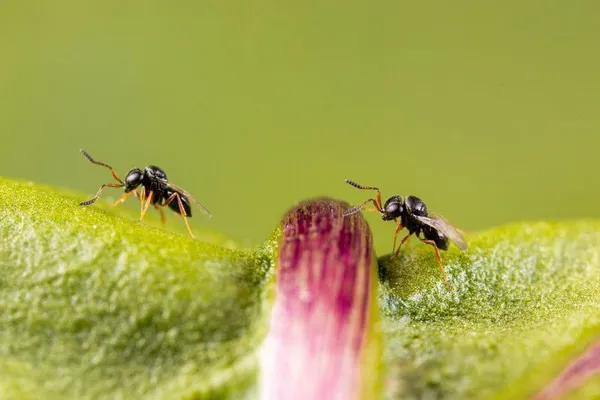Koppert's new product Nezapar can control the southern green stink bug Nezara viridula. The season is upon us.
Nezara viridula originates from Ethiopia and, in just a few short years, has expanded to become a notorious pest in sweet pepper, cucumber, and aubergine cultivation in Europe. The stink bug is able to survive in the winter, even in empty greenhouses, and is highly adept at hiding, which makes it hard for growers to deal with it at the end of the cultivation season or when changing crops. This makes a nice clean start to a new cultivation season all the more difficult.
Preventive use
Nezapar, the parasitic wasp Trissolcus basalis, produced by Koppert, is a new and effective treatment designed to help growers take control of the southern green stink bug. Using it in the right way is essential.

Trissolcus basalis only parasitizes the eggs of Nezara, so it's crucial that Nezapar is always used preventively; it needs to be present when Nezara deposits its first egg pouches. New Solutions field researcher Steven Voet from Koppert explains:
"Only if the grower is absolutely certain that there are no green stink bugs in the greenhouse can he wait until he expects to find them. Growers need to be careful, though. They can fly in at any time and quickly become established. If a neighboring grower already has them, there's a good chance that you'll be next."
As the stink bug is so good at hiding through the winter, preventive use is always the best approach.
"Field trials have shown that growers who use Nezapar once they've spotted signs of the first Nezara needed to move to higher doses earlier in the season. The savings made on the strategy at the start of the season were rapidly canceled out."
The best approach
Koppert recommends starting the preventive approach with one parasitic wasp per square meter per week. A bottle of Nezapar contains five thousand wasps. If the grower spreads the bottle evenly over fifty to a hundred spots or Diboxes per hectare, it will be well distributed - the parasitic wasp is highly mobile and good at searching.
If there are signs of Nezara (adults, egg pouches, or crop damage), the dose should be increased to three wasps per square meter per week. It still helps to remove as many stink bugs by hand as you can.
"Growers can deploy additional parasitic wasps around hotspots, so more than three per square meter. If you suffer from a major infestation or fly-in, you should use ten parasitic wasps per square meter per week for around four weeks and then remove the adults by hand."
Pesticides do not offer a solution
Growers can monitor the stink bug with effective scouting, but over large and very large premises, that requires time that often isn't available, so unpleasant surprises can never be entirely ruled out. It's also a good argument for having an army of parasitic wasps in the crop as a preventive measure.
And do pesticides offer any comfort against the southern green stink bug? They do exist, but they weaken the parasitic wasp and other beneficials. Steven Voet: "Pesticides aren't an option. They disrupt the established biological balance and can cause even greater problems when it comes to tackling other pests."
If a grower encounters an egg pouch from Nezara viridula, it's a good idea to leave it where it is and mark the spot. "The grower can use that spot to check whether he has used enough Nezapar. If he has, he'll notice that after a few days, the eggs of Nezara viridula have been visibly parasitized. The egg pouch can also be removed."
Prevent impending disaster
The Trissolcus basalis parasitic wasp is the most important natural enemy of the stink bug. Fertilized female wasps lay their eggs inside those of the stink bug – the larvae of the wasp then develop inside those eggs. Once they have pupated, they bite a hole in the Nezara egg, putting a stop to further population growth.
Koppert is the first to produce parasitic wasps in large numbers; with them, growers can deploy Nezapar at any time and prevent impending disaster.
For more information:
Koppert
[email protected]
www.koppert.com
